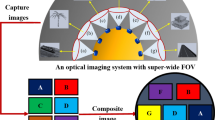Abstract
In order to reconstruct 3-D shape from two uncalibrated views, one needs to resolve two problems: (i) the computed focal lengths can be imaginary; (ii) the computation fails for fixated images. We present a practical remedy for these by subsampling feature points and fixing the focal length. We first summarize theoretical backgrounds and then do simulations, which reveal a rather surprising fact that when the focal length is actually fixed, not using that knowledge yields better results for non-fixated images. We give an explanation to this seeming paradox and derive a hybrid method switching the computation by judging whether or not the images are fixated. Doing simulations and real image experiments, we demonstrate the effectiveness of our method.
Similar content being viewed by others
References
Bougnoux, S. 1998. From projective to Euclidean space under any practical situation, a criticism of self calibration. In Proc. 6th Int. Conf. Comput. Vision, Bombay, India, pp. 790–796.
Brooks, M. J., de Agapito, L., Huynh, D. Q., and Baumela, L. 1998. Towards robust metric reconstruction via a dynamic uncalibrated stereo head. Image Vision Comput. 16(14):989–1002.
Chojnacki, W., Brooks, M. J., van den Hengel, A., and Gawley, D. 2000. On the fitting of surfaces to data with covariances. IEEE Trans. Patt. Anal. Mach. Intell. 22(11):1294–1303.
Hartley, R. I. 1992. Estimation of relative camera position for uncalibrated cameras. In Proc. 2nd Euro. Conf. Comput. Vision, Santa Margherita Ligure, Italy, pp. 579–587.
Hartley, R. and Silpa-Anan, C. 2002. Reconstruction from two views using approximate calibration. In Proc. 5th Asian Conf. Comput. Vision, Melbourne, Australia, vol. 1, pp. 338–343.
Hartley, R. and Zisserman, A. 2000. Multiple View Geometry in Computer Vision, Cambridge University Press,Cambridge, U.K.
Heyden, A. and Åström, K. 1997. Euclidean reconstruction from image sequences with varying and unknown focal length and principal point. In Proc. IEEE Conf. Comput. Vision Pattern Recog. Puerto Rico, pp. 438–443.
Huang, T. S. and Faugeras, O.D. 1989. Some properties of the E matrix in two-view motion estimation. IEEE Trans. Patt. Anal. Mach. Intell. 11(12):1310–1312.
Kanatani, K. 1993. Geometric Computation for Machine Vision, Oxford University Press, Oxford, U.K.
Kanatani, K. 1996. Statistical Optimization for Geometric Computation: Theory and Practice, Elsevier Science: Amsterdam, The Netherlands.
Kanatani, K. 1998. Geometric information criterion for model selection. Int. J. Comput. Vision, 26(3):171–189.
Kanatani, K. 2000. Optimal fundamental matrix computation: Algorithm and reliability analysis. In Proc. 6th Symp. Sensing via Image Inf. Yokohama, Japan, pp. 291–298.
Kanatani, K. 2004. Uncertainty modeling and model selection for geometric inference. IEEE Trans. Patt. Anal. Mach. Intell. 26(10):1307–1319.
Kanatani, K. and Matsunaga, C. 2000. Closed-form expression for focal lengths from the fundamental matrix. In Proc. 4th Asian Conf. Comput. Vision, Taipei, Taiwan, vol. 1, pp. 128–133.
Kanatani, K. and Ohta, N. 2003. Comparing optimal three-dimensional reconstruction for finite motion and optical flow. J. Electronic Imaging, 12(3):478–488.
Kanazawa, Y. and Kanatani, K. 2004. Robust image matching under a large disparity. In Proc. 6th Asian Conf. Computer Vision, Jeju, Korea, vol. 2, pp. 1128–1133.
Leedan, Y. and Meer, P. 2000. Heteroscedastic regression in computer vision: Problems with bilinear constraint. Int. J. Comput. Vision, 37(2):127–150.
Newsam, G. N., Huynh, D. Q., Brooks, M. J., and Pan, H.-P. 1996. Recovering unknown focal lengths in self-calibration: An essentially linear algorithm and degenerate configurations. In Int. Arch. Photogram. Remote Sensing, vol. 31-B3-III, Vienna, Austria, pp. 575–580.
Pan, H.-P., Brooks, M. J. and Newsam, G. 1995a. Image resituation: initial theory. In Proc. SPIE: Videometrics IV, Philadelphia, PA, USA, pp. 162–173.
Pan, H.-P., Huynh, D. Q., and Hamlyn, G. 1995b. Two-image resituation: Practical algorithm. In Proc. SPIE: Videometrics IV, Philadelphia, PA, USA, pp. 174–190.
Pollefeys, M., Koch, R., and Van Gool, L. 1999. Self-calibration and metric reconstruction in spite of varying and unknown internal camera parameters. Int. J. Comput. Vision, 32(1):7–26.
Sturm, P. 2001. On focal length calibration from two views. In Proc. IEEE Conf. Comput. Vision Pattern Recog. Kauai, HI, USA, vol. 2, pp. 145–150.
Ueshiba, T. and Tomita, F. 2003. Self-calibration from two perspective views under various conditions: Closed-form solutions and degenerate configurations. In Proc. Australia-Japan Advanced Workshop on Computer Vision, Adelaide, Australia, pp. 118–125.
Zhang, Z., Deriche, R., Faugeras, O., and Luong, Q.-T. 1995. A robust technique for matching two uncalibrated images through the recovery of the unknown epipolar geometry. Artif. Intell. 78 87–119.
Author information
Authors and Affiliations
Corresponding author
Rights and permissions
About this article
Cite this article
Kanatani, K., Nakatsuji, A. & Sugaya, Y. Stabilizing the Focal Length Computation for 3-D Reconstruction from Two Uncalibrated Views. Int J Comput Vision 66, 109–122 (2006). https://doi.org/10.1007/s11263-005-3952-y
Received:
Revised:
Accepted:
Issue Date:
DOI: https://doi.org/10.1007/s11263-005-3952-y




